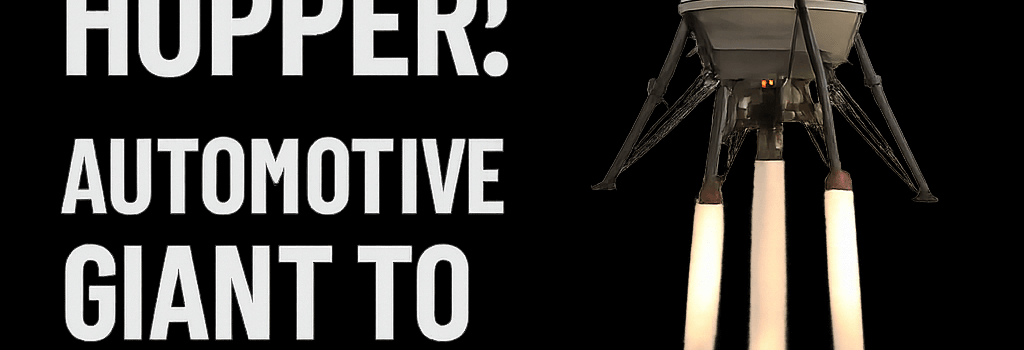Honda’s Rocket Hopper: Automotive Giant to VTVL Innovator

Introduction
On June 17, 2025, Honda Motor Company’s R&D division stunned the aerospace community with the first vertical takeoff, vertical landing (VTVL) rocket prototype flight conducted outside the United States and China. The subscale hopper climbed to 890 feet (271 m), then descended and landed within 37 cm of its target at Honda’s Taiki test facility in Hokkaido. Though small—standing just 6.3 m tall and 0.85 m in diameter—the test demonstrated key reusable-rocketry technologies long championed by SpaceX and Blue Origin, signaling Honda’s serious entry into space launch.
Flight Test Overview
Test Flight Profile
The experimental rocket, fully fueled weight ~1,312 kg, lifted off on cryogenic propellants at 10:00 AM JST. After a 10-second vertical ascent, it throttled back for altitude control and coasted to apogee. Upon descent, a precisely timed engine reignition and aerodynamically deployed grid fins guided the vehicle. The rocket’s legs extended moments before touchdown, arresting the descent with centimeter-level accuracy.
Hopper Design and Mechanisms
- Structure: Carbon-fiber fairing and titanium-reinforced landing struts.
- Grid Fins: Four titanium-alloy fins providing roll and pitch stability, stowed during ascent.
- Landing Gear: Retractable quad-legs with hydraulic dampers absorbing touchdown loads up to 50 g.
- Avionics: Redundant inertial measurement units (IMUs) and real-time flight computers running Honda’s proprietary guidance algorithms.
Engine and Fuel Technology
Video footage of the test shows a pale blue–orange exhaust plume typical of liquid methane/liquid oxygen (CH4/LOX) propulsion. Methalox offers higher performance (Isp ~360 s sea level) and cleaner operation than kerosene/LOX, aligning with Honda’s environmental goals.
Cryogenic Propulsion Systems
Honda engineers developed a closed-loop cooling chamber around the nozzle, employing regenerative cooling via methane fuel. Twin turbopump assemblies deliver ~40 bar chamber pressure, generating ~15 kN of thrust at liftoff. Cryogenic storage tanks use composite overwrapped pressure vessels (COPVs) with helium pressurization to maintain 20 K LOX and 112 K CH4.
Scaling Challenges and Road to Orbit
Transitioning from a subscale hopper to an orbital launcher requires eightfold thrust scaling, multi-stage integration, and first-stage booster recovery. Key challenges include:
- Structural Scaling: Increasing vehicle diameter and tank volume while maintaining mass margins.
- Thermal Management: Enhanced heat shielding for re-entry and stage separation at hypersonic velocities.
- Propellant Management: Zero-G propellant slosh control via baffles and positive expulsion systems.
Market Implications and Competitive Landscape
Honda’s success places it alongside SpaceX, Blue Origin, and Chinese startups like LandSpace and Galactic Energy. In Europe, ESA’s ArianeWorks is developing Themis (VTVL hopper) and Callisto demonstrators, both delayed into the late 2020s. Meanwhile, Toyota’s $44 million investment in Interstellar Technologies aims to mass-produce orbital-class vehicles using automotive manufacturing methods.
Japan’s Launcher Ecosystem and JAXA Initiatives
JAXA has long pursued reusable concepts under its Future Launchers Exploratory Programme. The agency’s collaboration with Mitsubishi Heavy Industries on the H3 rocket remains expendable, but funded research into reusable engines and guidance systems intersects with Honda R&D’s efforts. Japan’s national policy now encourages public–private partnerships to foster domestic launch capabilities and satellite services.
Expert Opinions and Analysis
“Honda’s demonstration of precise VTVL control is remarkable for a non-aerospace legacy firm,” says Dr. Keiko Tanaka, aerospace systems expert at the University of Tokyo. “Their experience in combustion and control systems from automotive engineering translates effectively, but scaling to orbital class remains a major engineering leap.”
“Methalox propulsion is a smart choice for reusability and emissions,” notes James Zimble, rocket propulsion consultant. “Honda’s closed-cycle turbopump and regenerative cooling design show they understand modern rocket engine tradeoffs.”
Beyond the Hopper: Future Plans and Partnerships
- By 2026: Final go/no-go decision on an orbital-class vehicle capable of lofting 1 ton to low Earth orbit.
- By 2029: Suborbital launcher test flights, verifying stage separation and recovery.
- Collaborations: Continued cooperation with JAXA, potential tie-ins with HondaJet avionics, and renewable energy systems for lunar rovers under Artemis.
Conclusion
Honda’s first VTVL rocket hopper flight is more than a proof of concept—it’s a signal that automotive giants can pivot their precision engineering into space technology. With cryogenic methalox engines, advanced control algorithms, and strategic partnerships, Honda is charting a path toward sustainable, reusable launch vehicles. The coming years will reveal whether the company can scale this success into orbital operations, but for now, Japan’s second-largest automaker has firmly entered the ranks of serious rocketry contenders.